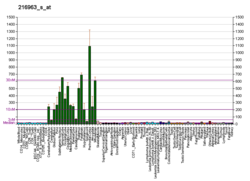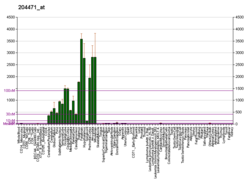Function
GAP43, is a cytoplasmic protein that can be attached to the membrane via a dual palmitoylation sequence on cysteines 3 and 4. This sequence targets GAP43 to lipid rafts. It is a major protein kinase C (PKC) substrate and is considered to play a key role in neurite formation, regeneration, and plasticity. [8] [9] The role of GAP-43 in CNS development is not limited to effects on axons: It is also a component of the centrosome, and differentiating neurons that do not express GAP-43 show mislocalization of the centrosome and mitotic spindles, particularly in neurogenic cell divisions. As a consequence, in the cerebellum, the neuronal precursor pool fails to expand normally and the cerebellum is significantly smaller. [10]
Several different laboratories studying the same protein, now called GAP43, initially used different names. It was designated F1, then B-50, then GAP43, pp46, and finally neuromodulin, each name reflecting a different function of the same molecule. [11] F1 was localized to synapses, and was increased in its phosphorylation one day after learning. However, F1 was not cAMP kinase dependent. B-50 was regulated by the pituitary peptide ACTH and was associated with grooming behavior. In the case of GAP-43, it was designated as a growth-associated protein because its synthesis was upregulated during axonal regeneration. Pp46 was concentrated in neuronal growth cones and was thus postulated to play an important role in brain development. In the case of neuromodulin, it was shown to bind calmodulin avidly.
GAP43, the consensus choice for its designation, [11] is a protein that is attached to the membrane via a dual palmitoylation sequence on cysteines 3 and 4, though it can exist in the non-bound form in the cytoplasm. This dual sequence enables the association of phosphatidylinositol-4,5-bisphosphate [PI(4,5)P2] or PIP2, with actin, facilitating the latter's polymerization thereby regulating cell structure. This can occur within a lipid raft so as to compartmentalize and localize motility of filopodia in growth cones in developing brains, and could also remodel presynaptic terminals in adults in an activity-dependent manner. GAP-43 is also a protein kinase C (PKC) substrate. Phosphorylation of serine-41 on GAP-43 by PKC regulates neurite formation, regeneration, and synaptic plasticity. [8]
Because of the association and potential binding of GAP43 with a number of different molecules, including PKC, PIP2, actin, calmodulin, spectrin, palmitate, synaptophysin, amyloid and tau protein, it may be useful to think of GAP43 as an adaptor protein situated within the terminal in a supramolecular complex regulating presynaptic terminal functions, particularly bidirectional communication with the postsynaptic process. Its important role in memory and information storage is executed through its cell biological mechanisms of phosphorylation, palmitoylation, protein-protein interaction and structural remodeling via actin polymerization.
This page is based on this
Wikipedia article Text is available under the
CC BY-SA 4.0 license; additional terms may apply.
Images, videos and audio are available under their respective licenses.





